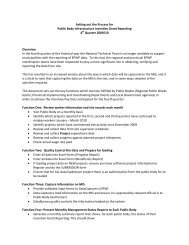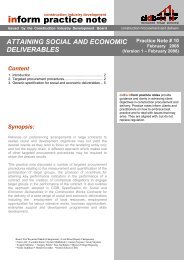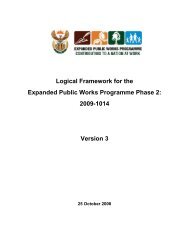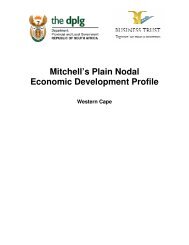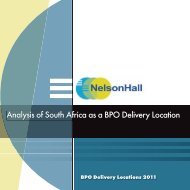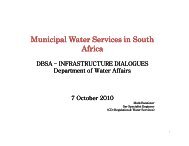Evaluation of the Monyetla Work Readiness ... - Business Trust
Evaluation of the Monyetla Work Readiness ... - Business Trust
Evaluation of the Monyetla Work Readiness ... - Business Trust
You also want an ePaper? Increase the reach of your titles
YUMPU automatically turns print PDFs into web optimized ePapers that Google loves.
Table 5: Project Management <strong>Evaluation</strong><strong>Evaluation</strong> <strong>of</strong> Project ManagementProject Scope• Was <strong>the</strong> project scope clearly outlined?• Were project deliverables, objectives and anysupporting detail clearly outlined?Scope Definition• Were major project deliverables clearly subdivided andoutlined to effect a favourable outcome <strong>of</strong> projectdelivery?Project Plan Development• Was <strong>the</strong> project plan consistent and coherent?• Were <strong>the</strong> <strong>Monyetla</strong> programme objectives consistentwith AsgiSA and NSDS objectives in terms <strong>of</strong> <strong>the</strong> SkillsDevelopment Act?• Is this information clearly stated in <strong>the</strong> original projectproposal and plan?• Were partnership roles clearly stated?Project Initiation• Was a feasibility study undertaken?• Was a project manager assigned to <strong>the</strong> project priorto execution and during planning stages?• Were project constraints, such as contractualprovisions and budgeting indentified?Resource Planning and cost control• Was adequate planning undertaken to determine whatresources (people, equipment, materials) and would berequired to perform project activities?• Were <strong>the</strong> costs allocated to <strong>the</strong> project sufficient for<strong>the</strong> delivery <strong>of</strong> <strong>the</strong> project to completion?• Did <strong>the</strong> project <strong>of</strong>fice have enough resources tomanage all consortia, to attend to all <strong>the</strong>ir concerns ontime and to address those successfully within <strong>the</strong>agreed turnaround time?• What was this turn-around time?Comments• The scope statement was clearly communicated andfocused on talent development and placements <strong>of</strong>learners. From this, clear project objectives were speltout.• Project deliveries stemming from objectives wereclearly outlined in terms <strong>of</strong> focus areas, outputs andactivities and captured in a “Scheme <strong>of</strong> <strong>Work</strong>”document. Although detailed timeframes wereprovided in <strong>the</strong> original project proposal, no suchevidence could be found in <strong>the</strong> “Scheme <strong>of</strong> <strong>Work</strong>”document. But again, records <strong>of</strong> meetings do indicate<strong>the</strong> various timeframes that were scheduled forcompletion before <strong>the</strong> quarterly Adjudication Panelmeetings.• The project plan showed high consistency with overallgap analysis results, project objectives and backgroundinformation pertaining to <strong>the</strong> need for this kind <strong>of</strong>intervention.• The objectives were linked to national priorities asidentified in AsgiSA, <strong>the</strong> requirements <strong>of</strong> existing andpotential investors, <strong>the</strong> McKinsey research and variouso<strong>the</strong>r research studies into <strong>the</strong> BPO&O sector inSouth Africa.• The project was designed to comply with relevantlegislation, such as <strong>the</strong> Skills Development Act, <strong>the</strong>Employment Equity Act, among o<strong>the</strong>rs.• Partnership roles between <strong>the</strong> dti, DoL, <strong>Business</strong><strong>Trust</strong>, BPeSA and o<strong>the</strong>r partners were assigned andclearly spelt out.• Since this is a pilot project, no feasibility studies wereundertaken, but, current research studies in <strong>the</strong> SouthAfrican BPO&O sector were used extensively toinform <strong>the</strong> structure <strong>of</strong> <strong>the</strong> project.• A project manager and technical advisor were assignedto manage <strong>the</strong> implementation <strong>of</strong> <strong>the</strong> programme.• Project constraints tended to be dealt with as <strong>the</strong>yarose and this was mainly because <strong>of</strong> <strong>the</strong> pilot status <strong>of</strong><strong>the</strong> project – <strong>the</strong> fact that <strong>the</strong> approach was beingtested; For example, consortia had to be flagged (usingcolour codes) in respect <strong>of</strong> <strong>the</strong>ir state <strong>of</strong> readiness todeliver <strong>the</strong> programme. Where consortia werestruggling to deliver, interventions had to be made.• Ano<strong>the</strong>r constraint that delayed <strong>the</strong> commencement <strong>of</strong>project activities was <strong>the</strong> legalities surroundingcontractual arrangements and in-house bureaucracy. Insome instances legal opinion had to be sought to clarifycertain contractual issues.• Sufficient planning as reflected in <strong>the</strong> initial 2006project plan was undertaken to determine resourcesrequired to implement <strong>the</strong> project. Available meetingdocumentation also reflect a high degree <strong>of</strong> planningprior to programme initiation. The project <strong>of</strong>ficeemployed a manager and one high-level technicaladvisor. Feedback from consortia indicated that <strong>the</strong>two human resources personnel were sufficient anddealt with all project issues timeously and adequately.Feedback indicated that a smaller project <strong>of</strong>fice withno departments was more efficient for fast pacedprojects with limited time frames for delivery, such as<strong>Monyetla</strong>. This was in sharp contrast to <strong>the</strong>bureaucratic barriers encountered by all <strong>the</strong> consortiamembers interviewed in <strong>the</strong>ir dealings with SETAs.26



